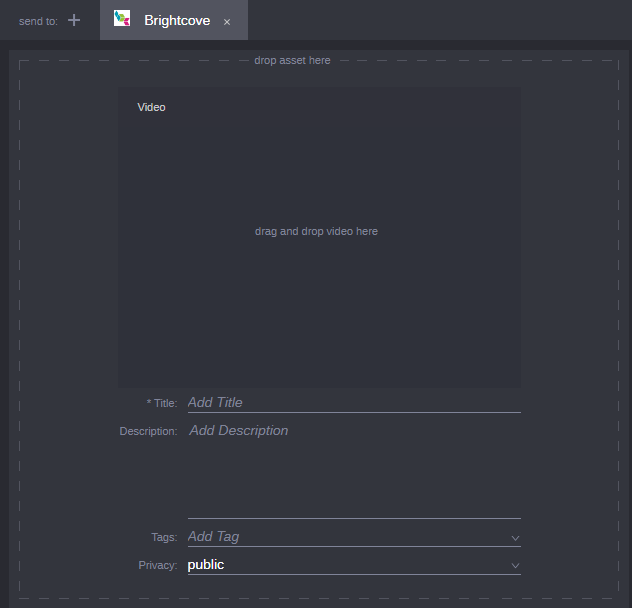Sending To: Brightcove
The send to Brightcove option enables users to send text and an associated media asset to the Brightcove online video platform.
Unlike endpoints such as Facebook or Twitter, you are not required to authorize a Brightcove profile in your user settings. Instead, your system administrator creates a Brightcove profile in the Workflow Settings app. Once that profile is created, the Brightcove endpoint is available to all users with the appropriate entitlements.
To publish to Brightcove:
1. If necessary, click the plus (+) button in the Send To menu to add a Brightcove endpoint.
The endpoint appears as a new tab as illustrated below.
3. Add a title to your package by entering text in the Title field.
4. (Optional) Add a short message to your package by entering text in the Description field.
5. (Optional) You can increase the likelihood that users will find your content by adding one or more add keywords or tags to your package. Click on the Add Tag field and enter text to create a custom tag. After you are done typing, press Enter (or Return on a Mac keyboard) to add the tag.
Each time you add a tag, it appears as a “pill” in the Tags field. You can add one or more tag as shown in the following illustration.

After adding a tag, you can easily remove it by clicking on the “x” to the right of the pill.
6. (Optional) Select an option from the Privacy menu.
- Public: All users can see the content. This is the default option.
- Private: Only certain users that you identify through Brightcove can see the content.
- Unlisted: Only the user who created the job can access the content.
7. (Optional) Configure additional endpoints as needed.
8. Finally, click the Publish button in the Publish header to complete the process.
If you want to watch the progress of your Publish job, open the Process app for a status of all jobs submitted by the current user. For more information about the Process app, see
Working with the Process App.
If your Publish job is successful, the information on your completed job is cleared from the Publish app, resetting all endpoints to their default configuration. If the job is not successful, the configuration information is maintained so that you can review and attempt the job again.


